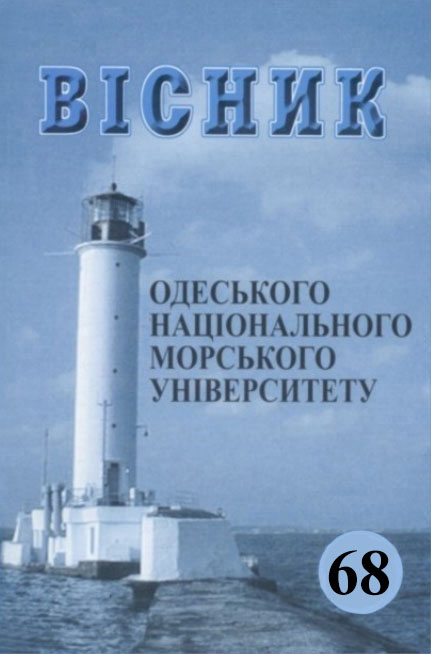Research of influence of operational factors on parameters fuel delivery accumulator system CR engines RT-FLEX
Main Article Content
Abstract
The results of a computational study of the influence of operational factors on the fuel supply process by the accumulator system CR of RT-flex engines are presented. In the model used in the study of fuel supply in the accumulator system processes that occur in all its essential elements are described. As an accumulator, a constant pressure source is considered. The most detailed analysis is the operation of the injection control unit that determines the processes in the high-pressure system. Carefully presented nozzles, the elements of which are fully consistent with the real design. A change in the basic characteristics of injection with variable values of the temperature of heating the fuel, its viscosity, pressure in the accumulator and the pressure of the nozzle needle lift is considered. The most significant effect is the viscosity and pressure in the accumulator. An increase in viscosity (lowering the heating temperature) leads to a significant decrease in the cyclic supply of fuel and a decrease in the stroke of the metering piston with constant fuel supply phases. The cycle delivery increases with temperature from 500 C to 90-1100 C from 0,013 to 0,022 kg – 1,69 times. Obviously, the determining factor in this dependence is the movement metering piston injection control unit. This indicator changes in a close way, increasing in the same range from 7.4 to 10.5-10.8 mm. Additional information about the movement of the QP is the speed of its movement. In the direct (working, injection) stroke, it increases with increasing temperature in the above range from 0,135 to 0,244 m / s. As for the fuel pressure in the nozzle, then the influence of temperature is small. It decreases from 610 to 600 bar − less than 2 % (in the ratio of 1,016). This pattern indicates the decisive influence of the hydraulic resistance of the elements of the high pressure path on the pressure in the nozzle. In a similar way, the injection parameters change with decreasing pressure in the accumulator. One of the operational parameters of the fuel supply system is the liftingpressure of the nozzle, which depends on the force from the spring. To assess the influence of the pressure of the nozzle lift, the injection process was simulated at various spring tightening pressures. The range of variation of was 300-450 bar with a nominal value of 375 bar. No noticeable effect was on injection characteristics. The change in the cyclic delivery does not go beyond 3,2 %; the difference in the path of the QP for the boundaries of the range is 2,2 %, and the velocity of the QP remains within 1,8 %. The pressure in the nozzle channel remains unchanged.
Article Details
References
2. Shen Haosheng. Visualization Simulation Research of Fuel Common Rail System of Marine Intelligent Diesel Engine / Shen Haosheng, Zhang Jundong, Cao Hui // Information Technology Journal. 2014. − 13 (9). − 1648-1655.
3. Tomi R. Diagnostics and Identification of Injection Duration of Common Rail Diesel Injectors/ R. Tomi Krogerus, J. Kalevi Huhtala // Open Engineering, 2018. − V. 8. – P.1-6. DOI: https://doi.org/10.1515/eng-2018-0001
4. Gill J.A Study of Small HSDI Diesel Engine Fuel Injection Equipment Faults Using Acoustic Emission / J. Gill, R. Reuben, J. Steel, M. Scaife, J. Asquith // Journal of Acoustic Emission. − 2000. 13. − P.211-216.
5. Hoffmann 0. Common Rail Diesel Injectors with Nozzle Wear: Modeling and State Estimation/ 0. Hoffmann, S. Han, D. Rixen // SAE Technical Paper. − 2017-01-0543. 2017.
6. Satкоski C. Cycle-to-cycle Estimation and Control of Multiple Pulse Profiles for a Piezoelectric Fuel Injector / C. Satкоski, N. Ruikar, S. Biggs, G. Shaver // American Control Conference on O'Farrell Street. – San Francisco, CA, USA. June 29 - July 01.2011. − P. 965-972.
7. Satkoski C. Piezoelectric Fuel Injection: Pulse-to-Pulse Coupling and Flow Rate Estimation / C. Satkoski, G. Shaver // IEEE/ASME Transaction on Mechatronics. − 2011(16). – P. 627-642.
8. Baur R. Estimation of Fuel Properties in a Common Rail Injection System by Unscented Kalman Filtering / R. Baur, Q. Zhao, J.В. lath, F. Kallage, M. Sthuttalbers, and C. Bohn // IEEE Conference on Control Applications (CCA). − Antibes, France. October 8-10. − 2014. – P. 2040-2047.
9. Akiyama H. Precise Fuel Control of Diesel Common-Rail System by Using OFEM / H. Akiyama, H. Vuasa, Α. Kato, T. Saiki et al // SAE Technical Paper. − 2010-01-0876, 2010.
10. Isermann R. Model-Based Fault Detection and Diagnosis for Common-Rail Injections Systems/ R. Isermann, S. Clever // MTZ. 2010(22).− P. 344-349.
11. Payri F. Injection Diagnosis through Common-Rail Pressure Measurement / F. Payri, J. Lujan, C. Guardiola, G. Rizzoni // Proceedings of the Mechanical Engineering, Part D: journal of Automobile Engineering. − 2006 (220). − P. 347-357.
12. Marker J. Potential of IN SITU Closed-Loop Control of Fuel Injection in Large LFO Engines / J. Marker, M. Willmann // Proceedings of 15th Conference of the Working Process of the Internal Combustion Engine. − Graz, Austria, September 24-25, 2015. – P. 393-402.
